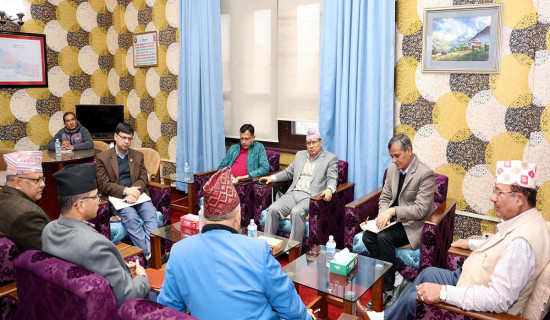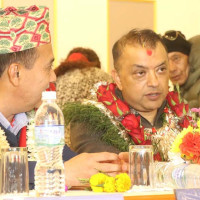- Saturday, 17 January 2026
Nilgai: Largest Antelope In Nepal, Asia
The Nilgai (Boselaphus Tragocamelus), literally meaning "blue cow," is the largest antelope in Asia. Nilgai is a pure vegetarian and is also the largest antelope species in Nepal. But there is no consensus as to which race Nilgai belongs to. However, according to a phylogenetic study in 1992, DNA testing revealed that the Nilgai originated from Bosalaphinae (goat and sheep species), Bovini cattle species, and Trzalaphinae (deer species). It can be seen in most of the Terai area of Nepal. It is also a powerful animal. The male Nilgai is as tall as a horse, but its body structure is not as balanced as that of a horse.
No Fear of Predators
The back of this animal is shorter than the front. For this reason, this animal is not a fast-moving animal. Therefore, predatory animals like tigers and leopards can hunt easily. However, killing a male Nilgai by a tiger or leopard is not so easy. Since the Nilgai lives mostly in open, dry places, this animal does not have to fear predators. The Nilgai can survive without drinking water for several days while the carnivore has to drink water every day due to the high sodium content in its body. For this reason, hunting animals rarely visit such dry areas.
Nilgai is not a very meaningful name for this animal. Because female swallows are brown. A light blue color is found only in adult males. It is a magnificent beast of a grayish blue or grayish gray color. Males have long and thick white hair on their bellies and white patches on their legs below the knees. Males are about 2.5 meters tall from the tip of the nose to the tip of the tail and about 1.5 meters tall at the shoulder.
Its weight can reach 250 kg. Females can weigh up to 220 kg. Females and males can be easily distinguished by the shape of their horns and body color. Nilgai improves smell and vision. The animal, however, has a low ability to hear. Nilgai is an herbivore, and its main diet is grass, leaves, flowers, and fruits. They especially eat berry fruits and mulberry flowers with much interest.
This animal is highly preferred by farmers for wheat, mustard, and other crops. Their most distinctive feature is that they live in places where they defecate. The farmers of the village estimate that there are more attacks on the fields by farmers who throw excrement. Sadhu Pandey, a local farmer in Rajwapur, says that if excreta is left in the farmers' fields, the farmers mix their excrement with water. They sprinkle it on the crops with a broom or a piece of neem. It has been observed that Nilgai does not go to that field during this activity. While this animal drinks a lot of water in hot weather, it can survive without water for 2 or 4 days in cold weather. With the help of its long bell, it reaches the high branches of the tree. However, because the front part of this animal's body is higher than the surface, it is difficult for this animal to climb the slopes of the mountain. For this reason, this animal is not found in the mountainous region of Nepal but in the Terai region.
Once kept by village farmers as cows, Nilgais are slightly larger. They are more agile and healthy than cows when they run around. Earlier, these wild animals used to live in forests and hilly areas. But due to the increasing population, people are now living in forested areas, so now it is seen in villages.
Nilgais usually roam in separate herds where males and females are separated. Male Nilgai can also be seen walking alone. Female Nilgai is also chased away from the pack by very powerful roosters. Male Nilgai usually focus on the same spot, but females do not. They especially defecate in open areas because they are easily seen by predatory animals lurking in hiding.
Each male dominates at least two female Nilgais. The Nilgai make barely any noise, but the female Nilgai sometimes sound like a buffalo. They can mate at any time. However, the main breeding season is between November and January, when the blue skin of the males is at its most beautiful. After mating, the males separate from the females and form their herds. Nilgai males and females become fertile after 18 to 30 months and 30 to 42 months, respectively. After about eight to nine months of gestation, the female gives birth to 1–3 cubs at a time. After giving birth, the female separates from the herd and places her children in other, safer places.
The average lifespan of this animal is 21 years. During the rainy season, the Nilgais hide in deep, dense forest thickets. These days, they have babies in their bellies. They prefer to stay in the bush only until a baby is born. When the rainy season ends and winter begins, they give birth to their babies. In October and November, along with the Nilgai, their young children are also seen. A Nilgai was like a cow but had two breasts, or udders, for milking.
Nilgai is a very cautious animal when it is grazing or resting in its pastures. They choose an open field or a garden with large trees to rest and sleep on each other's backs. While sleeping like this, one member of the herd keeps watch for the enemy in all directions. When Nilgai feels any danger from the enemy, she immediately stands up and starts calling her friends in a low voice.
Nilgai is one of the most active social animals during the day. Usually, they live in herds of at least 4 to 25, and sometimes their groups are very large. It can also be seen that male Nilgais roam alone in large areas after they are old.
The male Nilgai is very quarrelsome. They usually fight for women. The fighting style of these animals is also different. By bending the waist upwards like a bow and slowly circling an area, one tries to approach the area. When approaching, they nudge each other with their long and strong bells, sitting on their front knees. Thus, the sight of them fighting with bells makes them look like giraffes. The more powerful tries to strike his opponent's back. When the weak male swallows and runs away, the winning male too swallows and then runs after his opponent.
Habitat Loss
Habitat loss and degradation are among the main challenges of Nilgai conservation. They kill or injure the Nilgai in revenge for eating too much of the farmers' crops. Also, they hunt Nilgai for meat. In neighboring India, the Nilgai is one of India's lucky animals, preserved by the religious beliefs of Hindus. Since the word Nilgai is attached to the name of this animal, it is considered to be the sister of the cow and is not killed. A few years ago, after the Nilgai was killed in Bihar, India, there was a fight between the then-two chief ministers, Maneka Gandhi, and Prakash Zabadekar. Maneka Gandhi was known for her animal protection at that time.
Among the areas in Nepal where there are many Nilgais are the Lumbini development area of Rupandehi district and its surrounding villages, the villages of Kapilvastu district, etc.
There were two studies on Nilgai in Nepal carried out by 9Subedi, 2001, and Khatri 19930. In the said study, Rupandehi and Kapilvastu districts are potential Nilgai habitats, but no conservation measures have been taken. Therefore, the Nilgai population has declined at a high rate. (Subedi, 2001) It is necessary to identify Nilgai habitats and their carrying capacity. Population, rather than the carrying capacity of the habitat. In cases of excess, a translocation programme should be started to move the animals to other suitable places in the country. It is noted that this will also help reduce the damage to farming from the Nilgai experienced by the local people.
I spent one month and five days from December to January in different areas of the Rupandehi and Kapilvastu districts searching for different species of animals. In the same context, various rural parts of the Rupandehi and Kapilvastu districts were visited.
Rupandehi and Kapilvastu districts are once very famous for their Nilgai animals. First of all, in search of Nilgai, I visited various areas, including the Lumbini area of Rupandehi district and Bethari, but could not find Nilgai. Afterward, Bhadehar, Titarkha, Titarrkhi, Dharmapania, and Hardauna villages of Kapilvastu district were visited. In these villages, most of the Nilgai were seen in herds a few years ago. Because the farmers of the Rupandehi district and Kapilvastu district were cultivating wheat from December to January.
Nilgai is very fond of green wheat leaves. But I could not see Nilgai. Finally, on the 19th day of my stay, I saw male female Nilgais, and children grazing in 19 wheat fields in the middle of the village of Rajwapur (Taulihwa to Lumbini road) in Kapilvastu district. I got close to the Nilgai herd and started taking pictures. After some time, the Nilgai started to walk away, but a big male Nilgai looked at me and started coming toward me. Now, I had to run away to see if it would attack me. Also, the locals advised me to run away because it would attack me. This is how I was able to photograph Nilgai. When I was living in Kapilvastu, the residents once hunted Nilgai and used the meat, and security personnel arrested me. In Rupandehi district and Kapilvastu district, Nilgai is seen much less than it used to be. If the government of Nepal does not pay attention to the protection of this animal in time, there is a possibility that its number will decrease day by day.
(Dhungana is a senior wildlife photographer and writer)
















